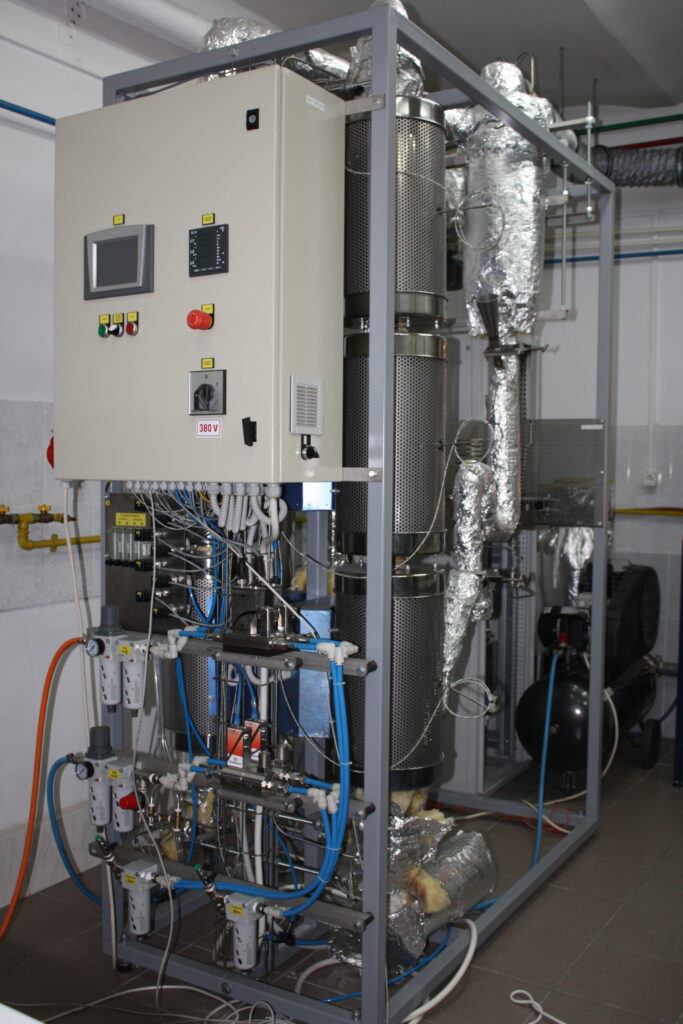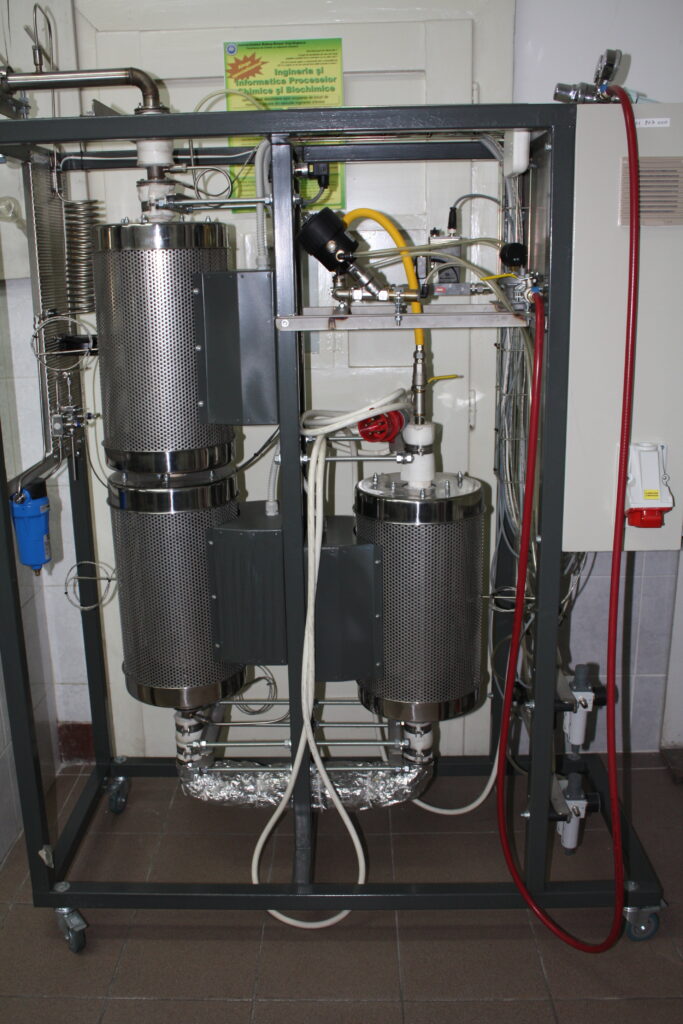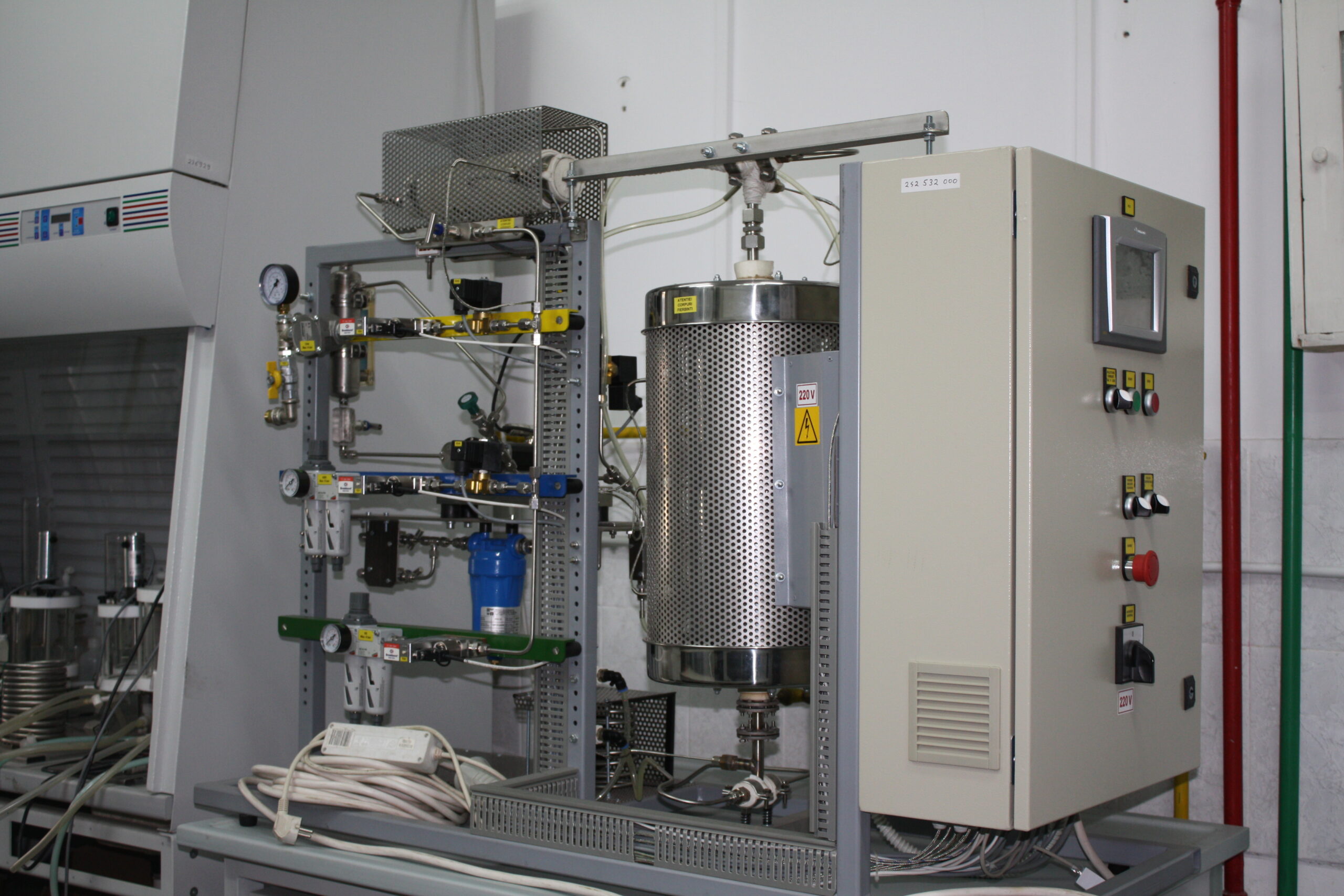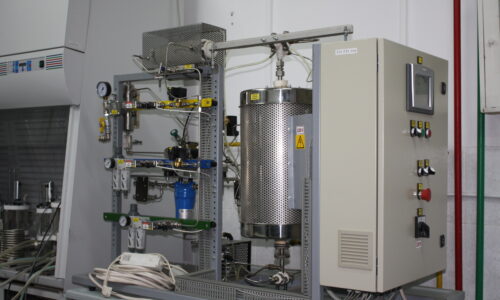Research centre: The experimental infrastructure dedicated to the energy conversion systems with CO2 capture belongs to the Computer Aided Process Engineering Research Centre (CAPERC) from Faculty of Chemistry and Chemical Engineering of University Babes-Bolyai (UBB) Cluj-Napoca, Romania. The Computer Aided Process Engineering Research Centre has gain international recognition in the field of mathematical modelling, simulation, control and optimization, as well as process integration and intensification, environmental evaluation of various processes for chemicals production and power generation as an integrated part of the Science, Technology, Engineering and Mathematics (STEM) system.
Research infrastructure: The available experimental infrastructure for energy conversion systems with CO2 capture has the following modules:
(i) Circulating fluidized bed (CFB) laboratory kit for evaluation of chemical & calcium looping systems for post-combustion CO2 capture. The pilot is composed of two vertical circulating fluidized bed reactors of about 1500 mm length and 30 mm diameter electrically heated (25 kW thermal) and supplied with temperature and pressure sensors. The maximum operating temperature is 1000oC at atmospheric pressure. The pilot can be used to evaluate the heterogeneous gas-solid systems operated in fluidized bed (catalytic and non-catalytic systems) being supplied with gas and solid sample extraction systems, cooler and condensate separation, air compressor, system monitoring and control using PLC and a dedicated computer (based on SCADA software);
(ii) Fixed bed laboratory kit for evaluation of energy conversion systems based on chemical looping with pre- and post-combustion CO2 capture. The kit is composed of one fixed bed reactor of 1000 mm length and 30 mm diameter electrically heated (about 6 kW thermal) and supplied with temperature and pressure sensors. The maximum operating temperature is 1000oC at atmospheric pressure. The pilot can be used to evaluate the heterogeneous gas-solid systems operated in fixed bed (e.g. catalytic and non-catalytic systems) being supplied with gas sample extraction systems, cooler and condensate separation, air compressor, system monitoring and control using PLC and a dedicated computer (based on SCADA software);
(iii) Fixed bed laboratory kit for evaluation of gaseous and liquid fuels conversion systems based on chemical & calcium looping with pre- and post-combustion CO2 capture. The pilot is composed of one fixed bed reactor of 300 mm length and 10 mm diameter electrically heated (about 3 kW thermal) and supplied with temperature and pressure sensors. The maximum operating temperature is 1000oC at atmospheric pressure. The kit is provided with a system (dosing pump + vaporiser) which enables the usage of liquid fuels (e.g., alcohols, hydrocarbons) as well as an electrical steam generator for oxygen carrier reoxidation. The pilot can be used to evaluate the heterogeneous gas-solid systems operated in fixed bed (e.g. catalytic and non-catalytic systems) being supplied with gas sample extraction, cooler and condensate separation, compressor, system monitoring and control using PLC and a dedicated computer (based on SCADA software);
(iv) Gas-liquid absorption column with Raschig rings for evaluation of physical and chemical scrubbing systems. The column has two section of 1 m in length and 10 cm in diameter being supplied with liquid pump, compressor, pressure measuring points and gas analyser.
These experimental rigs are serviced by analytical control systems as follow: (i) Siemens online gas analyser (IR and TCD detectors) dedicated to continuous monitoring of CO2, CO, CH4 and H2 from process gases. The equipment can be used for continuous monitoring of above-mentioned gaseous compounds from various lab and pilot experiments being supplied with sample extraction system, cooler and condense separation, monitoring and control using portable computer (laptop); (ii) Clarus 580 GC Arnel 4017PPC gas chromatograph with TCD and FID detectors specially dedicated to analysis of gaseous compounds resulted from various processes e.g. energy conversion systems such as gasification and reforming processes, oil refineries, combustion systems etc. The equipment can be used for analysis of gaseous and liquid samples and (iii) portable online gaseous analyser with TCD and IR detectors dedicated to continuous monitoring of CO2, CO, CH4 and H2 from process gases. This mobile equipment can be used for continuous monitoring of above-mentioned gaseous compounds from various lab and pilot experiments being supplied with sample conditioning system, cooler and condense separation, monitoring using portable computer (laptop) via USB or Wi-Fi connections. In addition to above mentioned experimental infrastructure, the research team has a wide variety of software’s for process simulation: Aspen, ChemCAD, Matlab/Simulink, Comsol, Thermoflex, GaBi etc.



Research and publications: The research team which is working on energy conversion systems with CO2 capture was involved in national and international research projects are mentioned below (selection): CaLby2030 – Calcium looping to capture CO2 from industrial processes by 2030, Horizon Europe, No. 101075416; Hybrid Solvent – Membrane for post-combustion CO2 capture and utilization, NO Grants, No. 13/2020; CONVERGE – Carbon valorisation in energy-efficient green fuels, Horizon 2020, No. 818135; 3D-CAPS: Three Dimensional Printed Capture Materials for Productivity Step-Change, ERANET ACT, No. 87/2017; SEWGS – Technology platform for cost effective CO2 reduction in the iron & steel industry, Horizon 2020, No. 640769; Advanced thermo-chemical looping cycles for the poly-generation of decarbonised energy vectors: Material synthesis and characterisation, process modelling and life cycle analysis, Romanian-Swiss Research Programme (RSRP), IZERZO_141976/1 etc.
The publication policy of our research group targets highly visible international ISI-ranked journals (such as Renewable and Sustainable Energy Reviews, Chemical Engineering Journal, Journal of Cleaner Production, Energy, Fuel, Applied Thermal Engineering, Renewable Energy, International Journal of Hydrogen Energy, International Journal of Greenhouse Gas Control etc.) and it can be fully checked on Scopus: Prof. eng. Calin-Cristian Cormos (https://www.scopus.com/authid/detail.uri?authorId=15071572300); Assoc. prof. eng. Letitia Petrescu (https://www.scopus.com/authid/detail.uri?authorId=55849749300) and Prof. Ana-Maria Cormos (https://www.scopus.com/authid/detail.uri?authorId=8450482900).
Keywords: Energy conversion systems; CO2 capture and utilization; Renewable energy sources; Energy vectors poly-generation; Chemical / calcium looping; Gas-liquid absorption; Membranes; Process design and integration; Modelling, simulation and optimization; Process control; Techno-economic and environmental impact assessment; Life Cycle Assessment (LCA).
Key Contact: Prof. PhD eng. Calin-Cristian Cormos
Email: calin.cormos@ubbcluj.ro
Telephone: +40-264-593833 / ext. 5737; Mobile: +40722304868
Website: http://www.chem.ubbcluj.ro/romana/ANEX/inginerie/proiecte/idei_cormos_calin_2021/Descriere%20infrastructura%20majora%20laborator%2013.pdf
Access policy and costs: The equipment’s are available Monday to Friday between 09:00 to 17:00. The specific accession time is depending on the ongoing testing campaigns and research activities done by our own faculty students (bachelor, master and doctoral). The following costs are foreseen for usage of the above-mentioned research infrastructure:
– UBB community: Consumable costs (e.g., various gases, oxygen carriers, catalysts, fuels), overheads (e.g., electricity, water) and lab. supervision;
– Other research entities: Consumable costs (e.g., various gases, oxygen carriers, catalysts, fuels), overheads (e.g., electricity, water), accessing cost (to be established based on work complexity and length as well as compatibility with targeted systems) and lab. supervision;
– Industry: Consumable costs (e.g., various gases, oxygen carriers, catalysts, fuels), overheads (e.g., electricity, water), accessing cost (to be established based on work complexity and length as well as compatibility with targeted systems) and lab. supervision.


